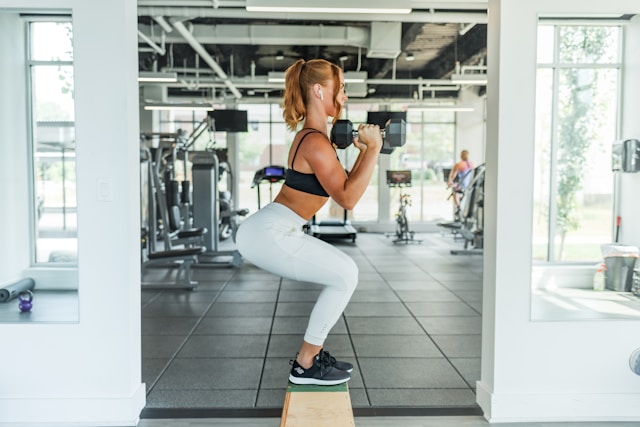We all know that fitness is an important part of our life. However, taking that first step is the most challenging thing to do. But we are here to help with this article, which will help you to design your own personal fitness plan uniquely tailored to your own abilities. Having a fitness plan that fits your exact needs is one of the best ways to ensure you stay committed to your fitness journey.
So, without further ado, let’s dive in.
Step 1: Know Your Fitness Goals
Before you start building your exercise plan, it’s essential to understand your fitness goals. Are you aiming to lose weight, gain muscle, improve your cardiovascular health, or simply maintain your current fitness level? Your goals will dictate the type of exercises you include in your plan.
Set Specific, Measurable Goals
When setting your fitness goals, make sure they are specific, measurable, attainable, relevant, and time-bound (SMART). For example, instead of saying, “I want to get fit,” you might say, “I want to lose 10 pounds in the next three months by exercising five days a week.”
Step 2: Assess Your Current Fitness Level
Knowing your starting point is crucial. Perform a fitness assessment to understand your current capabilities. This could include measuring your weight, body composition, strength, and endurance. Understanding your baseline will help you track progress and make necessary adjustments to your plan.

Step 3: Buy the Right Tools
Creating a fitness plan can be an enjoyable task with the right tools. We recommend measuring your progress with a wellness tracker.
One of the most important things to remember when doing any exercise is to stay hydrated and you can make it fun by using a Giotto water bottle. It is coded to show your progress and can inspire you to finish your daily intake of water.
Another important thing to consider for those that may have mobility issues is the availability of stationary leg exercise equipment such as the Cubii Total Body workout device. Many older individuals have this and mention its convenience in using while watching tv or when working from home.
Step 4: Designing Your Exercise Plan
Once you have a clear understanding of your goals and current fitness level, it’s time to design your exercise plan. A well-rounded exercise plan includes a mix of cardiovascular exercise, strength training, and flexibility exercises.
Cardio Workouts
Cardiovascular exercises, such as running, cycling, and swimming, are great for burning calories and improving heart health. Aim for at least 150 minutes of moderate-intensity or 75 minutes of high-intensity cardio per week. You can break this down into manageable sessions, such as 30 minutes five times a week.
Sample Cardio Workouts Routine(Low intensity)
Tuesday: Walk or jog for 30 minutes
Thursday: Walk or jog for 30 minutes
Saturday: Walk or jog for 45 minutes
Sunday: walk or jog 45 minutes
**This sample training plan is easily combined with our sample strength training plan below
Strength Training
Strength training helps build muscle mass, increase metabolism, and improve bone density. Include exercises that target all major muscle groups: chest, back, arms, legs, and core. Aim to strength train at least two days a week, allowing for rest days in between to let your muscles recover.
Sample Strength Training Routine
Monday: Upper Body Exercises: Sit-ups, bicep curls, tricep dips
Wednesday: Lower Body Exercises: Squats, lunges, deadlifts, leg presses, calf raises
Flexibility and Mobility
Flexibility exercises, such as stretching and yoga, help improve your range of motion and prevent injuries. Incorporate flexibility exercises into your routine whenever possible with a goal of 60 minutes of stretching per week. Even just 10 minutes of stretching after your workouts can make a significant difference.
We recommend combining flexibility training with our strength and cardio training plans by simply stretching 10 minutes per day that you work out for a total of 60 minutes per week. You could also attend one 60-minute yoga class per week to meet this goal.
Keep in mind that those with limited mobility may wish to replace some of the strength exercises with more flexibility exercises. If this is the case, plan to attend classes like yoga, pilates, or tai chi twice per week, as they combine strength training with flexibility for a well-rounded workout.
Related: The Best Exercise Classes for Older Adults

Step 5: Structuring Your Weekly Plan
Now that you know what types of exercises to include, it’s time to structure your weekly plan. A well-balanced weekly plan ensures that you get a mix of cardio, strength training, and flexibility exercises. Here’s an example of how you might structure your week:
Monday: Upper Body Strength
Tuesday: Cardio + Flexibility (stretching)
Wednesday: Lower Body Strength + Balance workout
Thursday: Light Cardio + Flexibility (stretching)
Friday: Rest
Saturday: Cardio + Flexibility (stretching)
Sunday: Rest or Active Recovery (e.g., walking, gentle yoga)
Step 6: Progression and Adaptation
As you continue with your exercise plan, it’s important to keep challenging yourself. Gradually increase the intensity, duration, and complexity of your workouts to avoid plateaus and keep making progress.
Track Your Progress
Keep a workout journal or use a fitness app to track your workouts, noting the exercises, sets, reps, and any other relevant details. Tracking your progress helps you see how far you’ve come and identify areas that may need adjustment.
Adjust Your Plan
Listen to your body and be willing to make adjustments to your plan. If you find that certain exercises are causing pain or discomfort, modify them or try alternatives. It’s also important to incorporate rest and recovery to prevent overtraining and injuries.
Hydration
Exercise is just one part of the equation. Proper hydration is critical for achieving your fitness goals. To ensure your daily liquid intake, try using a water bottle, such as the Giotto bottle.
Related: The Importance of Staying Hydrated: Your Body’s Lifeline
Eat a Balanced Diet
Eat a balanced diet rich in whole foods, including plenty of fruits, vegetables, lean proteins, whole grains, and healthy fats. Tailor your diet to your specific goals. For example, if you’re looking to build muscle, ensure you’re getting enough protein.
Related: Healthy Eating Hacks for Seniors
Rest and Recovery
Don’t underestimate the importance of rest and recovery in your exercise plan. Your body needs time to repair and build muscle tissue, so make sure you’re getting adequate sleep and taking rest days as needed. We recommend starting with at least 2 rest days a week, though you can lower it to one rest day over time.
Active Recovery
Incorporate active recovery days into your plan, where you engage in low-intensity activities like walking, gentle yoga, or stretching. This helps keep your body moving without putting too much strain on your muscles.
Step 7: Stay Motivated
Staying motivated is key to sticking with your exercise plan. Here are some tips to keep you on track:
- Set Short-Term Goals: In addition to your long-term goals, set smaller, short-term goals that you can achieve along the way. These can provide a sense of accomplishment and keep you motivated.
- Find a Workout Buddy: Having a workout partner can make exercise more enjoyable and hold you accountable. Find a friend, family member, or coworker who shares similar fitness goals.
- Mix It Up: Variety is the spice of life, and it’s also essential for a successful exercise plan. Try new activities and workouts to keep things interesting and prevent boredom.
- Reward Yourself: Celebrate your achievements, big and small. Treat yourself to a new workout outfit, a massage, or a fun outing when you reach a milestone.
Overall, building your own exercise plan is a rewarding process that puts you in control of your fitness journey. By setting clear goals, incorporating a variety of exercises, and staying flexible with your plan, you can create a routine that is both effective and enjoyable. Remember to track your progress, listen to your body, and stay motivated. With dedication and consistency, you’ll be well on your way to achieving your fitness goals.
You May Also Enjoy: The Health Benefits of Tai Chi


















